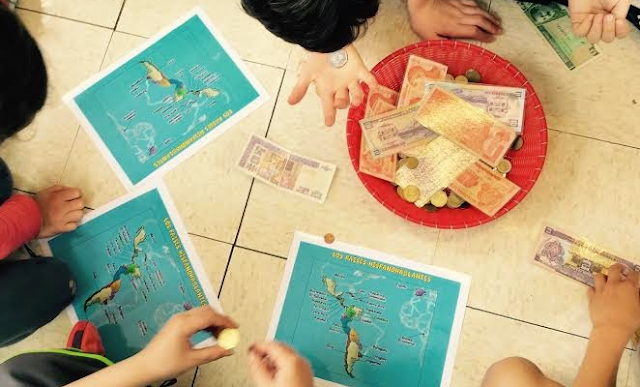Las Ollitas {Traditional Game}
Para preparar el sancocho,
pongo el pollo,
pongo la yuca,
pongo la papa,
pongo la mazorca,
lo pongo al fuego.
Variation: You can use visuals for the students to use while playing the game.
Para preparar el sancocho,
pongo el pollo,
pongo la yuca,
pongo la papa,
pongo la mazorca,
lo pongo al fuego.
Variation: You can use visuals for the students to use while playing the game.

Over several years of teaching Spanish I have collected coins and bills from different Spanish speaking countries. Either someone brings them to me or I collect them during my own travel. I got to a point where I didn’t know what to do with them. It occurred to me that I could use them for a center in my class. I laminated all the bills for students to manipulate easily and placed them with the coins in a basket. I printed and laminated maps where all the Spanish speaking countries are listed.
This game has been motivating my second graders a lot lately. We did a unit on family members, we talked about the diversity in families, and they then described their own immediate families orally and in a small written project.
I modified the well known game called “Who Stole the Cookie for the Cookie Jar?” to support this unit. Instead of a cookie, I printed a picture of an empanada. This added a small cultural twist to the game (and made me hungry for Colombian comfort food…).
I told my students the story of abuelita, who made just one empanada and that someone in the family had eaten it without her permission. I added a detective to this version.
I printed a picture of a detective and gave it to one student. I also gave printed pictures of different family members to the rest of my students. I got them from my “La Familia” set that I have in my TpT store. When you play it, you can also print pictures of family members from other sources.
I gave each student in the room one picture to represent a family member, and I made sure to include pets such as a cat and dog.
Before playing the game, I made sure to go over the lines of the chant. We chanted every line and also helped the detective say his/her line.
Once you have assigned the different pictures of family members to the students, choose one student to be the detective. The detective will have to leave the classroom. While the detective is outside the room, give a student with the picture of a family member the picture of the empanada. Everyone in the room has to pretend to have the empanada in their hands.
The detective comes back to the classroom and will have three opportunities to guess who has the empanada.
The class chants:
¿Quién se comió la empanada de mi abuela? (two times)
The detective answers:
¿El papá se comió la empanada de la abuela? (two times) Usually the class helps the detective chant.
Depending on who has the empanada the class will answer:
“El papá no se comió la empanada de la abuela.”
or
“El papá sí se comió la empanada de la abuela.”
Remember that the detective has three turns to guess. You can play this game for a long time in class and get everyone using some language skills that they’ve learned in your class.